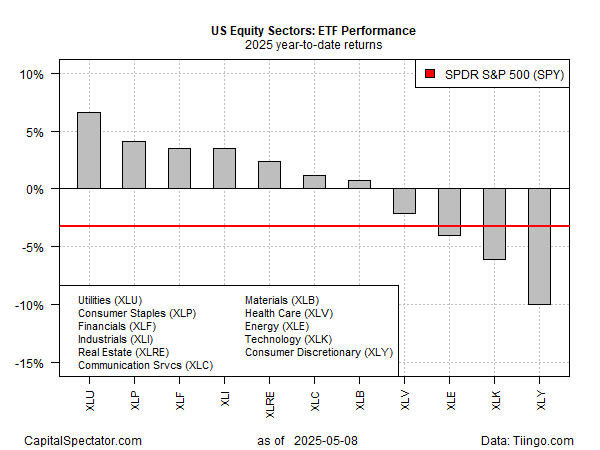Tesla could be a $10,000 stock in a decade, says longtime bull Ron Baron
President Trump announced a US-UK trade deal yesterday, which may be an early sign of a thaw in the global trade war. Talks between China and the US scheduled for this weekend could bring more good news. However, with tariffs still in place, sentiment in the US equity market remains cautious, based on a review of equity sectors via a set of ETFs through yesterday’s close (May 8).
Although the broad US stock market has rebounded sharply in recent weeks, the recovery has yet to reverse a wide lead for defensive equities. Utilities (XLU) are the top sector performer year to date, posting a 6.6% increase. American shares overall (SPY) are still down so far this year, shedding 3.3%.
That’s dramatically better than the 15% loss in early April, but there’s still a long way to go for the market to regain its world-beating momentum that was on display as recently as January.
It’s telling that the worst-performing sector this year is consumer discretionary stocks (XLY), which are down 10%. By contrast, consumer staples (XLP) are up 4.1% so far in 2025.
A key reason for the gap: expectations that consumer spending will take a hit, or at least be redirected away from non-essential purchases as tariffs lift prices in the months ahead.
A new survey by the Federal Reserve finds that companies are planning to pass cost increases from tariffs on to consumers. “The bottom line is that inflation will be rising significantly over the next six months,” predicts Apollo Global Management chief economist Torsten Slok.
Meanwhile, recent consumer survey data points to elevated anxiety about higher prices, which implies that headwinds for consumer spending may be brewing.
“Having both firms and consumers saying prices are going to go up is not a good combination for the Fed,” said Diane Swonk, the chief economist at KPMG. “It’s yet another thing keeping them from doing anything with interest rates until they get more clarity on what the actual impacts are.”
Anticipating higher prices, consumers appear to be frontrunning purchases to avoid tariff-related hikes. A survey published this week from the National Retail Federation shows that retail sales grew in April.
“Spending rose again in April, driven largely by consumers continuing to pull purchases forward to stay ahead of tariffs that will inevitably lead to higher prices,” NRF President and CEO Matthew Shay said. “Despite declines in confidence caused by the economic uncertainty that has come with tariffs, consumer fundamentals remain intact, supported by low unemployment, slower-but-steady income growth and solid household finances.
Consumers maintain their ability to spend and have strong reasons to spend now before tariffs can drive up prices or cause shortages on store shelves.”
To be fair, there’s a lot of uncertainty about how tariffs will affect the economy, including consumer spending. These are still early days and so debate rages about how events will evolve in the months ahead.
What is clear is that the stock market is still pricing in higher risk for consumer discretionary stocks (XLY) while redirecting investment flows into consumer staples and other defensive equity sectors. Animal spirits may be laying the groundwork for a comeback, but it’ll take stronger news than yesterday’s US-UK trade deal to persuade the crowd that tariff risk is fading in a big way. Perhaps this weekend’s US-China talks will help move the needle.
